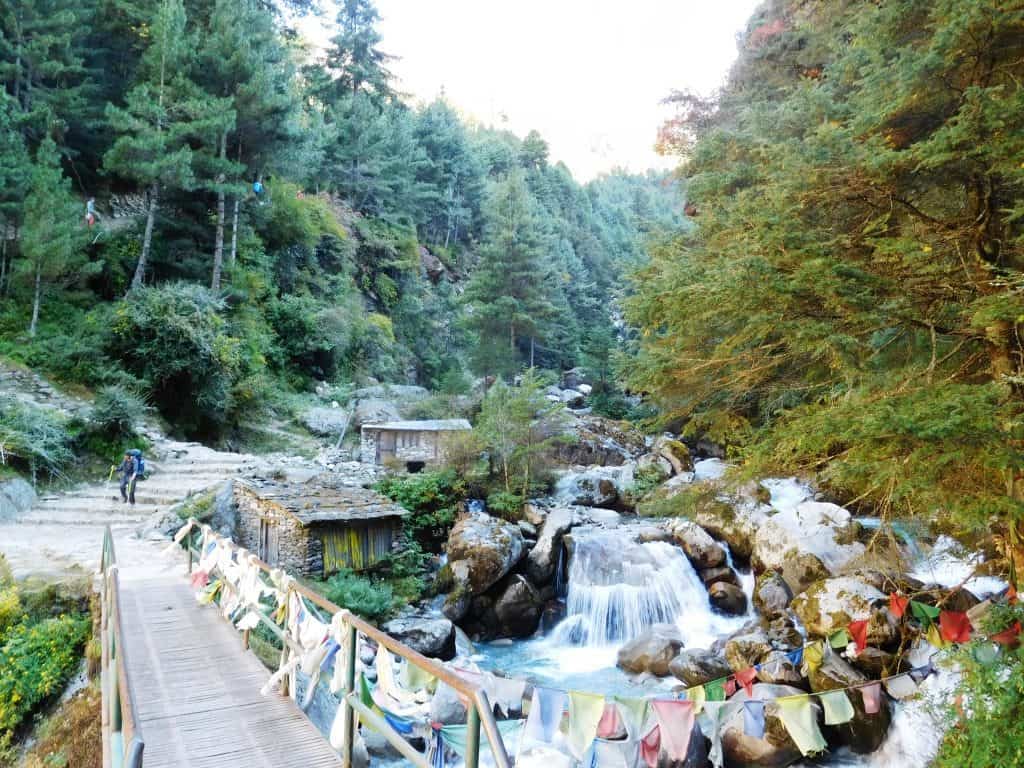It is a pleasant and easy couple of km descent through a pretty forest from Lukla to the prosperous looking agricultural town of Chheplung (though it is much harder struggling back up the other way on the return journey with a chest full of pneumonia!)
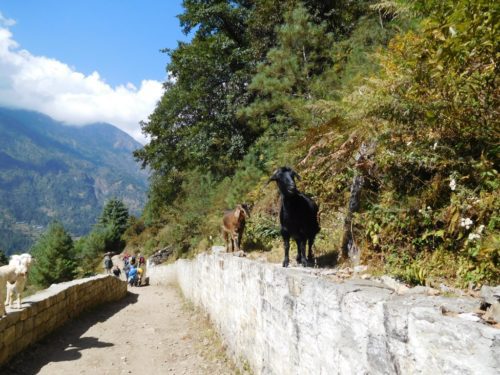
Soon you will see no more playful goats as they are banned from the National Park.
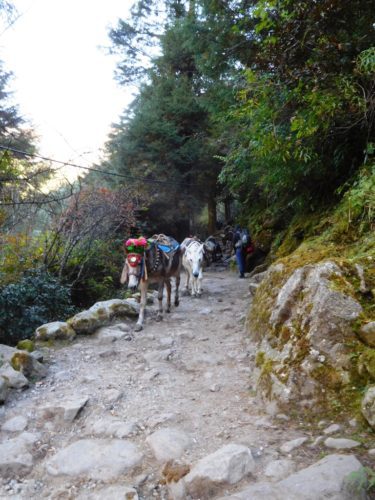
Pretty and well cared for donkeys along the way.
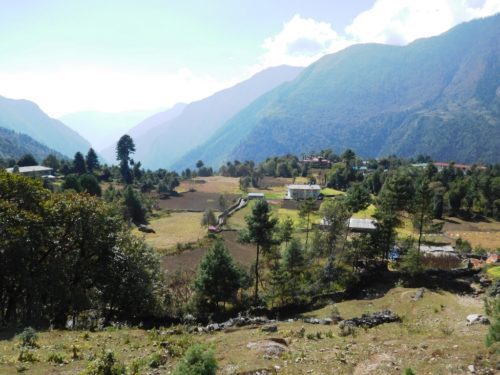
Chheplung is a well laid out and prosperous looking agricultural area.
From there you follow the Dudh Khosi River upstream with only slight rises and falls of the path until you ascend sharply 7-800 metres into Namche Bazar after a walk of approx 8 hours. Most complete this section over two days.
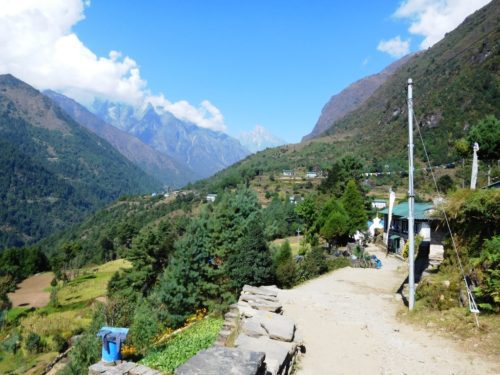
There are many small villages.
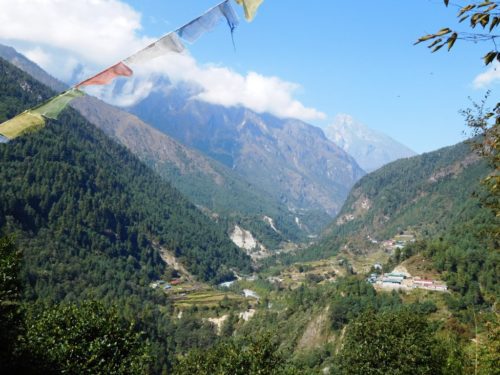
And places to take a break.
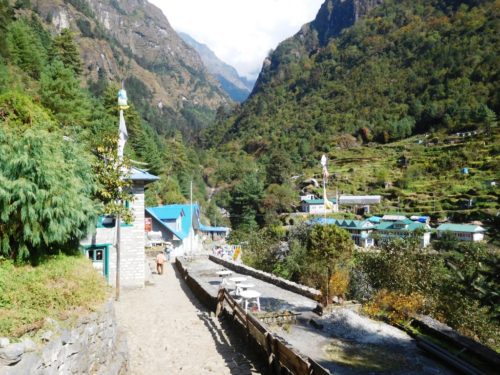
Some more salubrious than others: Of course along the well-travelled section of the EBC most everything is dressed up to its best. In smaller rural villages you often find rougher accommodation.
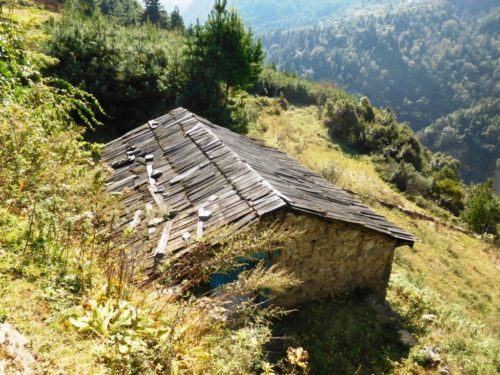
There are lots of big and little villages to stop along the way to enjoy a cup of coffee (or something stronger), a snack or a meal. We planned to stop at Monjo (because of its altitude rather than its being half way), but we spent a little too long ‘catching up’ before we set off, so that we ended up staying at the Himalayan Guest House (nice), Bengkar instead. Most folk stay at Phakding (quite a big town) which is about half way to Namche, but there is no need; every tiny hamlet has its tea houses for food and accommodation.
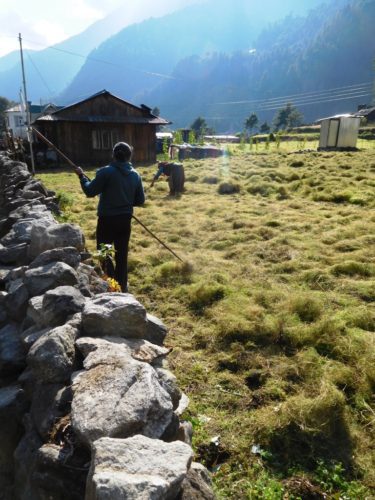
Quaint agricultural practices: this hay is being ‘raked’ with a stick. I saw it cut with a kitchen knife! I can think of some improvements here: sometimes on our Hazelwood farm we would make 14,000 bales of hay in an afternoon!
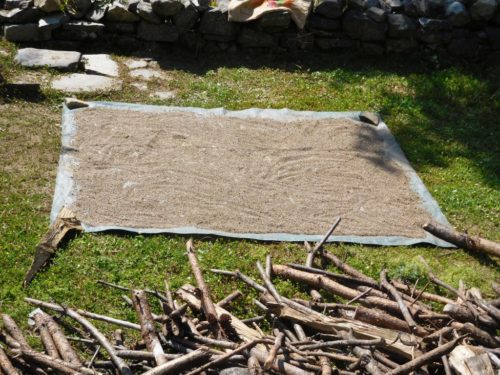
Sun drying barley, I guess. Strangely in the tea houses everyone eats Dahl Bhat (Rice) even though no rice could grow here.
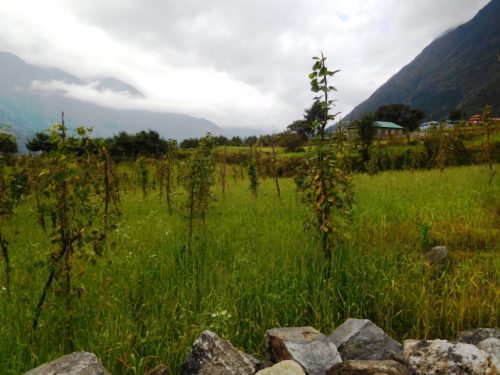
I found the intercropping interesting; beans and grain grown together.
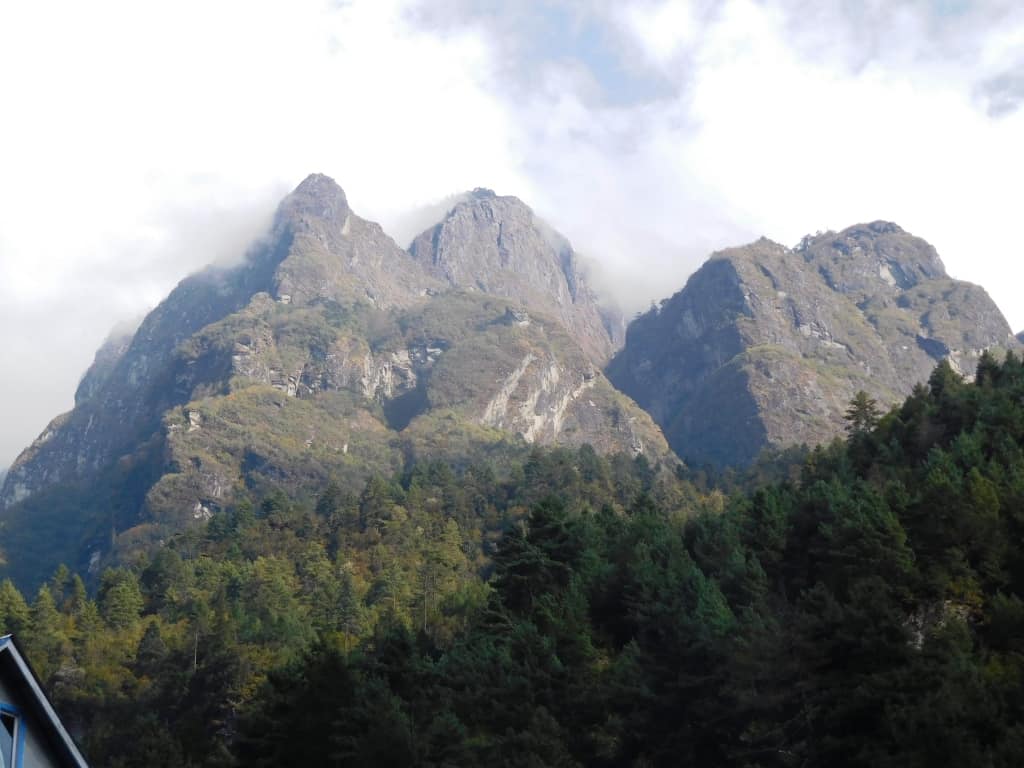
Everywhere the mountains tower over the valley:
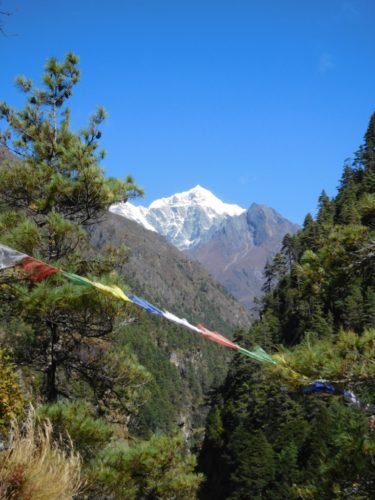
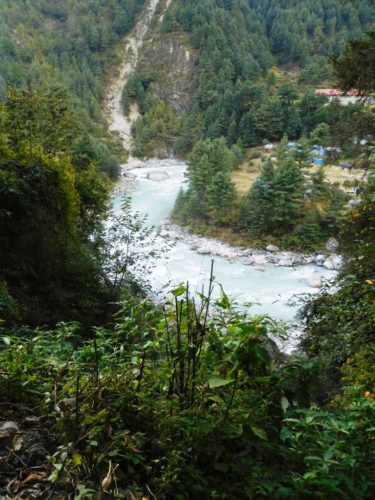
And the river churns in its bed:
All along the route telephone and/or internet reception is mixed/patchy, but usually available – though it may surprise you that there is any at all. Often there is wifi eg in guest houses, etc. Sometimes it is free; at others it might cost eg US$5 for 200 megs. It is lovely though to be able to use ‘Whats App’, ‘Facebook Messenger’ or etc to conduct telephone or video calls with your loved ones on the other side of the world! (I know I did.)
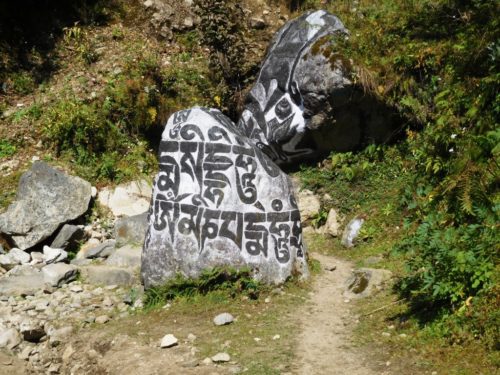
Endless religious gibberish pollutes the scenery.
Everywhere in Nepal (as in many such places) bullshit religious iconography is ubiquitous. Such a country is enormously held back by such religious and (leftist) political primitivism. Of course it does not help you much if your Maoist Government somehow still pathetically claims that the entire royal family just shot itself early one morning (perhaps this is what happened to the Romanovs too?) I am minded of a similar bizarre (unsolved murder?) case in Vic where the victim managed to shoot herself twice in the head with a bolt action rifle! Meanwhile they inflict punitive taxes eg on antisocial things like autos (250%!) and stow the purloined cash into their vast bureaucratic coffers to later be used (at personal need) for their own Apparatchik purchases (dachas/limos – surely you know the story by now?)
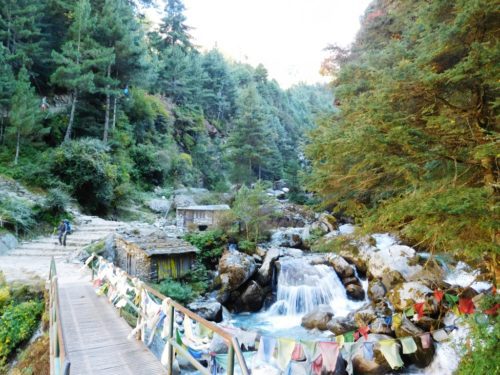
Of course religion can be beautiful too. I was particularly impressed by these automated ‘prayer mills’. This must save some time grovelling in the dust muttering incantations!
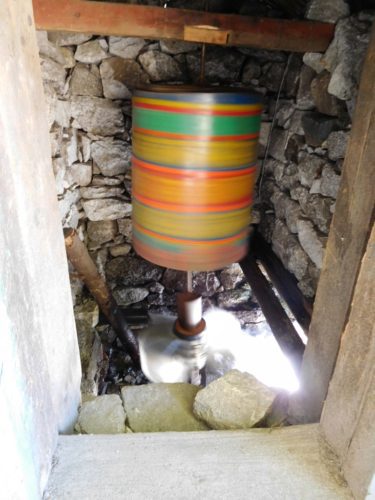
A ‘Prayer-o-matic’!
Any damned fool (from Cecil Rhodes on, though he was not one – what an amazing man with his Cape to Cairo Railway; the only person in history to have not one, but two whole countries named after him even though he only lived to be around fifty – a boy by my reckoning!) can see that Nepal must have a modern conduit to the sea, else the efficient transport of goods/services and all the wealth that trade brings will never emerge. The Maoists will not even build roads. These (hiking) tracks we stumble along are funded entirely by the donations of kind passers by and built by the local villagers.
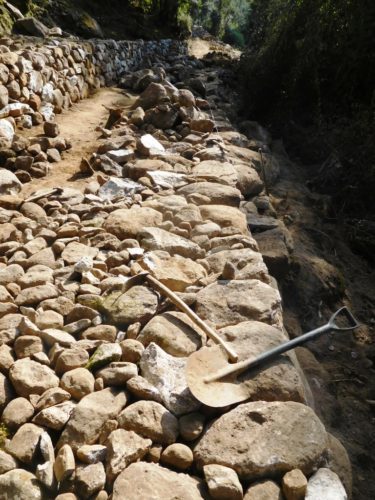
Freeway construction Nepali style.
An old man whose sign indicated he had sumitted Everest five times was collecting for just such track repairs just out of Namche – and the track was being repaired right there with the proceeds. You scarce ever see that sort of thing from any government! Once they have the money, it’s gone!
Meanwhile folk stagger by carrying loads on their backs which small lorries would not be ashamed of. We often saw young teenagers (girls and boys) carrying 15 slabs of canned booze up huge mountains for the later delectation of rich foreigners. PS: Is ‘Everest’ so named because of the likelihood that if you climb it you will ‘ever rest’ there – as some hundreds (starting with Mallory), do?
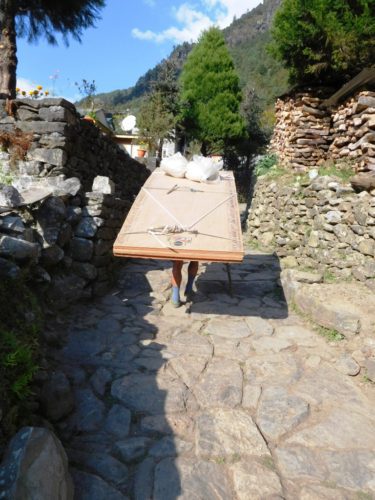
No ‘Worksafe’ here.
This poor guy staggered along under the weight of over half a cubic metre of plywood. Some other poor devil had hauled in on their backs the huge steel stoves used to heat the lodges, weights of 150 kg, I’d guess! You just know that in many of the huts you pass by there must be just such dreadfully broken human beings weeping and praying to Buddha, just as other poor beggars call out uselessly to Allah or Christ elsewhere. Will such religious nonsense never end?
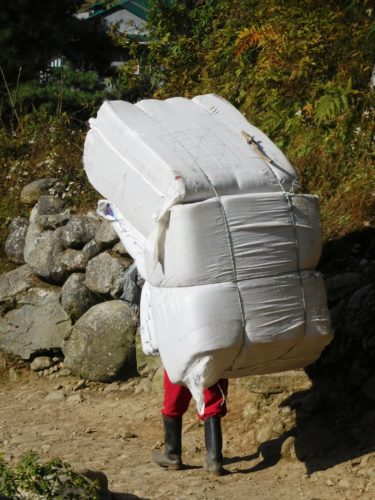
Santa Claus has lost his reindeer.
I saw one poor man staggering along under a monstrous load, a huge swelling on the side of his face where a tooth was abscessed or etc. He clutched at it tenderly and shuffled on, tears in his eyes – you know it will be ever so, until his death. Dental problems are yet the world’s single biggest killer. There is not a lot really romantic about living in those mountains even if they might seem pretty to us – which is why the seething millions hanker for the smogs and overcrowding of Kathmandu, etc.
Of course the UN and other such Leftist ‘aid’ organisations hold lots of meetings there to discuss what ‘small is beautiful’ world solutions might help, then find (mysteriously) at meeting’s end that all the funding has been spent on the meetings! The population is left to pull itself up by its own bootstraps – which it will, but much more slowly than it might if it got just a little help up. A road here and there, for example.
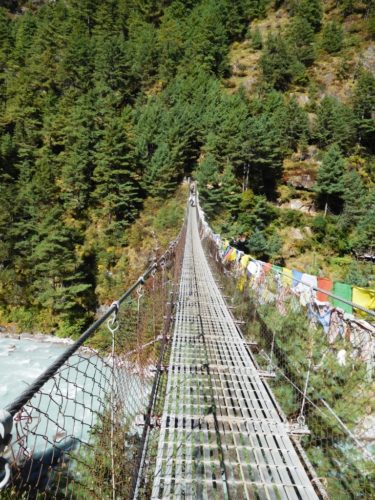
Bridge at Phakding. Keep and eye out for the turnoff here on the way back (I know I missed it!)
There is a very long bridge across the river at Phakding which you would be well served to give the yaks first turn at, and maybe count how many others are aboard before you venture forth your feet. It is not near so high as the highest ‘double bridge’ just as you begin the climb up the mountain towards Namche (below). ‘Tully’ reckoned it to be 150 metres down to your death on the sharp teeth of the river far below. I did not demur – being too fearful to look down!
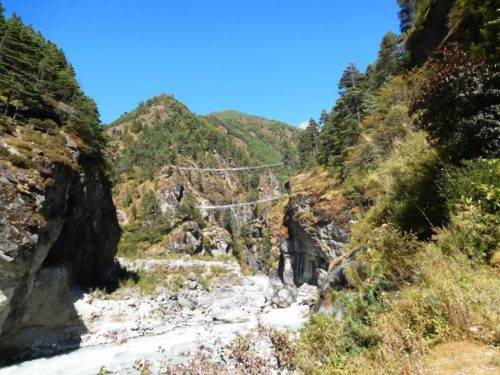
Old and new bridge.
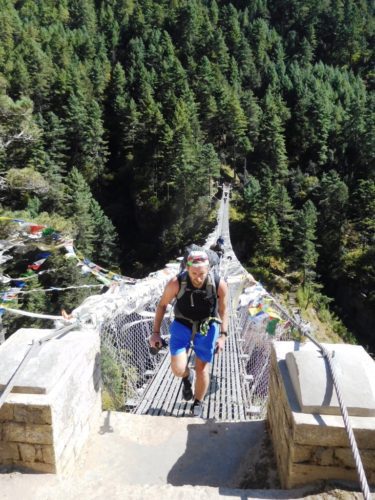
Tully surges off the high bridge. I can guess why.
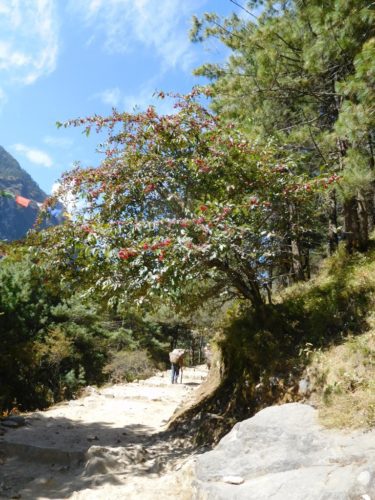
On the slopes climbing up to Namche (and elsewhere) there are some interesting plants – many extensively gnawed by yaks or hacked by folk for kindling. Others appear sacred to man and beast alike. This one (a crab apple?) for example. I noticed a beautiful blackberry with pure white canes too.
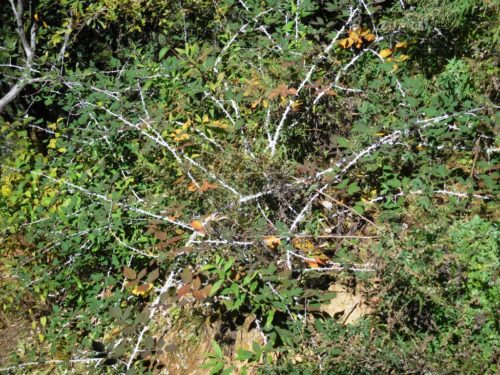
Whiteberries.
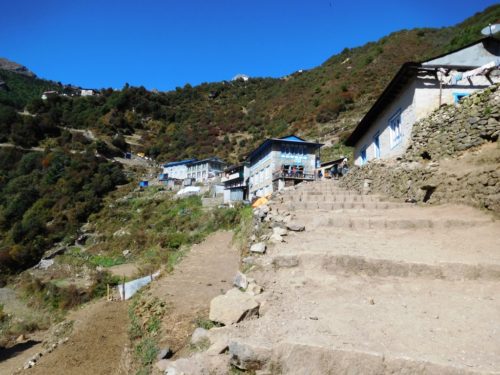
Coming up the rise in to Namche
Namche is quite a large town with plenty of ‘hotels’ and very many shops, including a pharmacy, a mobile phone repairer – pretty much everything you can think of. If you start the trek at Lukla with only your credit card you will be able to buy everything needful along the way. This is not a wilderness trek such as I am used to. This is a well-supplied highway for feet!
See also:
http://www.theultralighthiker.com/i-followed-my-footsteps/
http://www.theultralighthiker.com/i-saw-below-me-that-golden-valley/
http://www.theultralighthiker.com/to-the-roof-of-the-world/
http://www.theultralighthiker.com/everest-base-camp-three-passes-trek/
http://www.theultralighthiker.com/cold-weather-face-masks/
http://www.theultralighthiker.com/my-life-was-wide-and-wild-and-who-can-know-my-heart/

